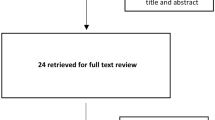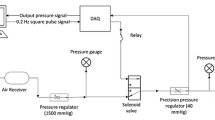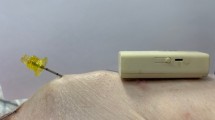Abstract
Objective. Venous oximetry catheters provide useful realtime information about mixed venous hemoglobin saturation (Svo2). Currently available systems utilize either two or three wavelengths of light to obtain these measurements. Previous animal and clinical studies have attempted to compare the accuracy of these two devices under similar circumstances. However, the relative accuracy of the two-wavelength versus three-wavelength systems has never been assessed under identical conditions. For this purpose, we designed an animal model for simultaneous measurement ofSvo2 over a wide range of physiologic and pathologic states.Methods. Seven anesthetized swine underwent simultaneous placement of two- and three-wavelength catheters. Paired data points consisted of values obtained from a reference oximeter and from each of the catheters. Observations were obtained every 15 min during the following manipulations: (1) eucarbic hypoxia induced by reducing Fio2 to 0.18, 0.15, and 0.12 for 15 min each; (2) simulated surgical manipulation; and (3) hypovolemic shock produced by hemorrhage to a mean arterial pressure of 50 torr for 1 hr. Data were analyzed by calculation of mean error (bias) and precision for each system in comparison with the oximeter.Results. The overall error of the two-wavelength system was +0.15%, with a precision of ±2.54%. The three-wavelength system had an overall error of +3.71%, with a precision of ±2.30%. Overall correlation between catheterSvo2 and oximeter values was the same for both devices (r=0.99).Conclusions. Both currently available in vivo spectrophotometric systems are capable of producing satisfactory results over wide ranges ofSvo2. In contradistinction to older reports, we found that the two-wavelengthSvo2 system produced results equivalent to those obtained from the three-wavelength device. In this regard, there is no detectable advantage in accuracy to measuring in vivoSvo2 with three rather than with two wavelengths.
Similar content being viewed by others
References
Buele PL, McMichan JC, Marsh MB, et al. Continuous monitoring of mixed venous oxygen saturation in critically ill patients. Anesth Analg 1982;61:513–517
Diverte MB, McMichan JC. Continuous monitoring of mixed venous oxygen saturation. Chest 1984;85:423–428
Schmitt JM, Mihm FG, Meindl JD. New methods for whole blood oximetry. Ann Biomed Eng 1986;14:35–52
Chulay M, Palmer J, Neblett J. Clinical comparison of two-and three-wavelength systems for continuous measurement of venous oxygen saturation. Am J Crit Care 1992;1:69–75
Gettinger A, DeTraglia MC, Gloss DD. In vivo comparison of two mixed venous oxygen saturation catheters. Anesthesia 1987;66:373
Hecker BR, Brown DL, Wilson D. A comparison of two pulmonary artery mixed venous oxygen saturation catheters during the changing conditions of cardiac surgery. J Cardiothorac Anesth 1989;3:269–275
Scuderi PE, Bowton DL, Meredith JW, et al. A comparison of three pulmonary artery oximetry catheters in intensive care unit patients. Chest 1992;102:896–905
Karis JH, Lumb PD. Clinical evaluation of the Edwards laboratories and Oximetrix mixed venous oxygen saturation catheters. J Cardiothorac Anesth 1988;2:440–444
Leighton T, Liu SY, Lee TS, et al. Simultaneous in-vivo comparison of 2-versus 3-wavelength mixed venous oximetry catheters (Abstract). Anesthesiology 1991;3A:A10
Bland JM, Altman DG. Statistical methods for assessing agreement between two methods of clinical measurement. Lancet 1986;1:307–310
Gore J, Sloan K. Use of continuous monitoring of mixed venous saturation in the coronary care unit. Chest 1984;86:757–761
Bongard FS, Leighton TA. Continuous dual oximetry in surgical critical care. Ann Surg 1992;216:60–68
Author information
Authors and Affiliations
Additional information
This work was supported by a grant from Baxter Edwards Critical Care, Irvine, California.
Rights and permissions
About this article
Cite this article
Bongard, F., Lee, TS., Leighton, T. et al. Simultaneous in vivo comparison of two-versus three-wavelength mixed venous (Svo 2) oximetry catheters. J Clin Monitor Comput 11, 329–334 (1995). https://doi.org/10.1007/BF01616992
Received:
Revised:
Accepted:
Issue Date:
DOI: https://doi.org/10.1007/BF01616992




